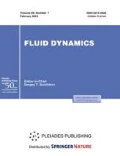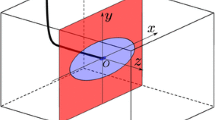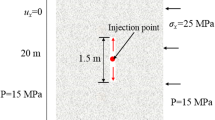Abstract—
The planar quasi-three-dimensional model of propagation of a hydraulic fracture in the reservoir characterized by the heterogeneous fracture toughness is constructed to investigate the fluid flow and fracture evolution. In order to simulate the heterogeneous layered reservoir with various fracture toughnesses, three typical cases of the reservoir are considered, namely, the reservoir with zones of weakness, the homogeneous reservoir, and the reservoir with zones of increased strength. The results show that heterogeneous fracture toughness of the reservoir affects strongly the shape of fracture, the fluid flow, and the general fracture opening (width) as compared with the homogeneous reservoir in which the radial fracture growth is implemented. Moreover, the effect of the heterogeneous fracture toughness of the reservoir on the fracture growth is mainly noted in the earlier stage. After a certain instant of time, the fracture propagates in various directions at approximately identical velocity.














Similar content being viewed by others
REFERENCES
Perkins, T.K. and Kern, L.R., Widths of hydraulic fractures, J. Petrol. Technol., 1961, vol. 13(9), pp. 937–949.
Nordgren, R.P., Propagation of a vertical hydraulic fracture, Soc. Petro. Eng. J., 1972, vol. 12(4), pp. 306–314.
Warpinski, N.R., Schimidt, R.A., and Northrop, D.A., In-situ stresses: the predominant influence on hydraulic fracture containment, J. Petrol. Technol., 1982, vol. 34(3), pp. 653–664.
Nolte, K.G., Application of fracture design based on pressure analysis, SPE Prod. Eng., 1988, vol. 3(1), pp. 31–42.
Advani, S.H. and Lee, J.K., Finite element model simulations associated with hydraulic fracturing, Soc. Petrol. Eng. J., 1982, vol. 22(2), pp. 209–218.
Settari, A. and Cleary, M.P., Development and testing of a pseudo-three-dimensional model of hydraulic fracture geometry, SPE Prod. Eng., 1986, vol. 1(6), pp. 449–466.
Adachi, J., Siebrits, E., Peirce, A., and Desroches, J., Computer simulation of hydraulic fractures, Intern. J. Rock Mec. Mining Sci., 2007, vol. 44, pp. 739–759.
Gordeev, Yu.N., Self-similar solution of the problem of pseudo-three-dimensional vertical hydraulic fracture propagation in an impermeable stratum, Fluid Dynamics, 1995, vol. 30, no. 6, pp. 870–876. https://doi.org/10.1007/BF02078202
Li, D., Zhang, S., and Zhang S., Experimental and numerical simulation study on fracturing through interlayer to coal seam, J. Natur. Gas Sci. Eng., 2014, vol. 21, pp. 386–396.
Xiao, H.T. and Yue Z.Q. A three–dimensional displacement discontinuity method for crack problems in layered rocks, Intern. J. Rock Mec. Mining Sci., 2011, vol. 48, pp. 412–420.
Wardie, L.J., Displacement discontinuity method for three-dimensional stress analysis of tabular excavations in non-homogeneous rock, in: The 25 th U. S. Symposium on Rock Mechanics (USRMS), 1984, June 25–27, Evanston, Illinois, pp. 702–709.
Settari, A. and Cleary, M.P., Three-dimensional simulation of hydraulic fracturing. J. Petrol. Technol., 1984, vol. 36(7), pp. 1177–1190.
Akulich, A.V. and Zvyagin, A.V., Interaction between hydraulic and natural fractures, Fluid Dynamics, 2008, vol. 43, no. 3, pp. 428–435. https://doi.org/10.1134/S0015462808030101
Smirnov, N.N. and Tagirova, V.P., Self-similar solutions of the problem of formation of a hydraulic fracture in a porous medium, Fluid Dynamics, 2007, vol. 42, no. 1, pp. 60–70. https://doi.org/10.1134/S0015462807010073
Josh, M., Esteban, L., Piane, C.D., Sarout, J., Dewhurst, D.N., and Clennell, M.B., Laboratory characterisation of shale properties, J. Petrol. Sci. Eng., 2012, vols. 88–89, pp. 107–124.
Siebrits, E. and Peirce, A.P, An efficient multi-layer planar 3D fracture growth algorithm using a fixed mesh approach, Intern. J. Num. Meth. Eng., 2002, vol. 53, pp. 691–717.
Zia, H. and Lecampion, B., PyFrac: A planar 3D hydraulic fracture simulator, Comp. Phys. Comm., 2020, vol. 255, p. 107368.
Zia, H., Lecampion, B., and Zhang, W., Impact of the anisotropy of fracture toughness on the propagation of planar 3D hydraulic fracture, Int. J. Fract., 2018, vol. 211, pp. 103–123.
Moukhtari, F.-E., Lecampion, B., and Zia, H., Planar hydraulic fracture growth perpendicular to the isotropy plane in a transversely isotropic material, J. Mec. Phys. Solids, 2020, vol. 137, p. 103878. https://doi.org/10.1016/j.jmps.2020.103878
Peirce, A. and Detournay, E., An implicit level set method for modelling hydraulically driven fractures, Comp. Meth. Appl. Mec. Eng., 2008, vol. 19, pp. 2858–2885.
Spence, D.A. and Sharp, P., Self-similar solutions for elastohydrodynamic cavity flow, Proc. Math. Phys. Eng. Sci., 1985, vol. 400(18), pp. 289–313.
Zhang, X., Detournay, E., and Jeffrey, R., Propagation of a penny-shaped hydraulic fracture parallel to the free-surface of an elastic half-space, Int. J. Fracture, 2002, vol. 115, pp. 125–158.
Savitski, A.A. and Detournay, E., Propagation of a penny-shaped fluid-driven fracture in an impermeable rock: asymptotic solutions, Int. J. Solid and Structures, 2002, vol. 39, pp. 6311–6337.
Savitski, A.A. and Detournay, E., Similarity solution of a penny-shaped fluid-driven fracture in a zero-toughness linear elastic solid, Comptes Rendus de l’Académie des Sciences. Series IIB: Mechanics, 2001, vol. 329, pp. 255–262.
Chen, X., Li, Y., Zhao, J., Xu, W., and Fu, D., Numerical investigation for simultaneous growth of hydraulic fractures in multiple horizontal wells, J. Nat. Gas. Sci. Eng., 2018, vol. 51, pp. 44–52.
Sesetty, V. and Ghassemi, A., A numerical study of sequential and simultaneous hydraulic fracturing in single and multi-lateral horizontal wells, J. Petrol. Sci. Eng., 2015, vol. 132, pp. 65–76.
Xiao, H.T. and Yue, Z.Q., A three–dimensional displacement discontinuity method for crack problems in layered rocks, Int. J. Rock Mech. Mining Sci., 2011, vol. 48, pp. 412–420.
Funding
The authors wish to thank the support from the China Scholarship Council and the Program of Basic Research of the Russian Academy of Sciences (project no. АААА-А18-118041190145-1 (0065-2019-0021 and 0580-2021-0021)).
Author information
Authors and Affiliations
Corresponding author
Additional information
Translated by E.A. Pushkar
Rights and permissions
About this article
Cite this article
Kiselev, A.B., Kay-Zhui, L., Smirnov, N.N. et al. Simulation of Fluid Flow through a Hydraulic Fracture of a Heterogeneous Fracture-Tough Reservoir in the Planar 3D Formulation. Fluid Dyn 56, 164–177 (2021). https://doi.org/10.1134/S0015462821020051
Received:
Revised:
Accepted:
Published:
Issue Date:
DOI: https://doi.org/10.1134/S0015462821020051




